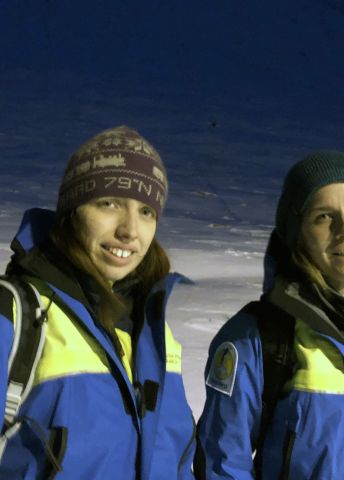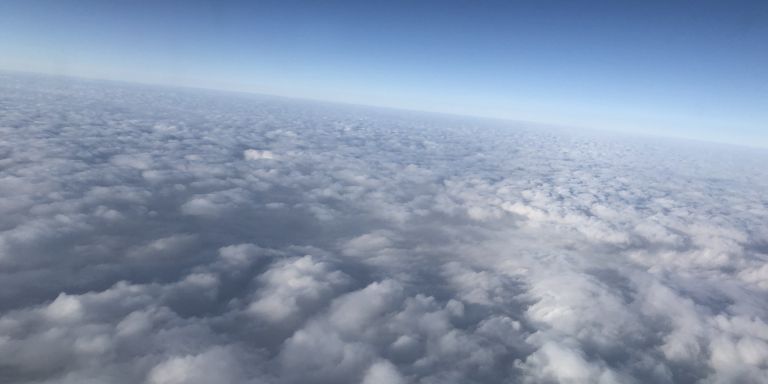
Sophie Hasslet and Wallenberg Academy Fellow Claudia Mohr, Stockholm University, measures air particles at the research station Ny-Ålesund at Svalbard.


Sophie Hasslet and Wallenberg Academy Fellow Claudia Mohr, Stockholm University, measures air particles at the research station Ny-Ålesund at Svalbard.
Aerosols and clouds are the two greatest obstacles to our ability to understand and predict climate change. Claudia Mohr is studying aerosols – particles needed so that clouds and raindrops can form. Accompanied by a team of researchers, she will monitor particles and gases in the air and clouds at the Ny-Ålesund research station on Svalbard for a year.
Ny-Ålesund is just over 1,230 kilometers from the North Pole. The air here is very clean, with few particles.
“There is 10,000 times less particle mass per cubic meter of air than in Delhi, which we visited in January to record levels there,” Mohr explains.
Dust, pollen, and soot are examples of aerosol particles – minute particles finely distributed in a gas.
Mohr is concentrating on the chemical composition of organic particles. These particles may be natural or man-made; sources include vehicular emissions or wood burning and emissions from vegetation.
The Zeppelin Observatory perches atop Mount Zeppelin just south of Ny-Ålesund, and is currently home to Mohr’s monitoring equipment. High up on the mountain, only two lights pierce the polar night enveloping Ny-Ålesund when Claudia arrives there for the first time. She is two days late due to a cancelled flight. She eyes the observatory anxiously.
“I’m like a mother hen, worrying about my instruments. They’re so sensitive, and I know something is wrong,” she says. She will have to wait until the next day before she can take the cable car up to the observatory.
The most important measuring instrument is a mass spectrometer – the same one they used in Delhi. Her PhD students Karolina Siegel and Yvette Gramlich, and postdoc Sophie Haslett, had helped to pack the mass spectrometer in Stockholm. Gramlich and Haslett had then installed it in the observatory a few weeks earlier; it was a stressful and risky job.
“Six large crates weighing a total of 800 kilos had to be packed and transported by truck to Tromsø in Norway. Then they had to be loaded onto a boat. If the truck had missed the boat, we would have had to wait two months for the next one. When the crates arrived, they were loaded onto a forklift truck and taken to the cable car. We secured them to the side of the cable car with straps,” Haslett recalls. She has also joined Mohr on this trip.
They also had to saw up a table to get the equipment into the research station.
“It took us three weeks to install the equipment and get it up and running. In Delhi it only took three or four days. Conditions can vary, you might say,”
But the mass spectrometer is now in place, and monitors the air every second – at molecular level.
“We want to find out where organic aerosols in the Arctic come from – whether they are transported there from elsewhere, or have a local source. We want to see the whole life cycle – from emission/source to whether they become a particle, and whether they form a clouddrop,” Mohr explains.
One of the reasons for choosing to carry out the monitoring now is that MOSAiC, the largest polar expedition ever, is in progress at the same time. The polar research ship Polarstern will spend a full annual cycle drifting in the Arctic sea ice, gathering data. The aim is to gain a better understanding of the regional and global consequences of ongoing climate and environmental changes in the Arctic.
“Among other things, this will enable us to compare our monitoring results from Mount Zeppelin with data collected at sea and on the ice,” Mohr says.
Another reason they want to monitor for a whole year is their desire to obtain a complete picture of the organic aerosol population.
“We know it varies at different times of year due to factors such as sunlight, ice cover, vegetation, or transport from the continental regions further south,” says Haslett.
Clouds play a major part in global temperature variation. Clouds can prevent incoming sunlight from warming the ground, and thus have a cooling effect. But they can also trap heat emitted from the ground and therefore have a warming effect.
Since cloud droplets form on airborne particles, the aerosol particles have an influence on how many clouds are formed, and how bright they are. This in turn influences how good they are at reflecting incoming sunlight back to space.
“The situation in the Arctic is more complicated, since snow and ice also reflect sunlight, and the ice cover in the Arctic is decreasing rapidly. We don´t fully understand the complex connections between changes in sea ice and cloud cover, and how that will influence the Arctic region, which is warming faster than anywhere else”, Haslett comments.
In a place as clean as the Arctic very small changes can have a huge impact.
“Less ice cover and thus more open water means more shipping, which means that in the future we can expect more emissions. This may impact entire ecosystems, which in turn impact particles and clouds,” Mohr says.
For the first time, they will be using their instruments to measure not only aerosols, but also cloud water and cloud droplets. They will also be taking snow samples.
When asked whether they are optimistic or pessimistic about climate trends, the researchers’ replies differ somewhat.
“I choose to be optimistic in spite of everything. I think we’ll find a solution, but the changes will have left their mark. Life will be much more problematic for many people,” Mohr says.
“I think it’s hard not to be affected, particularly here on Svalbard. I’m afraid we won’t be able to change things fast enough,” Haslett replies.
Both agree that political resolve will be needed to reverse the trend, and to persuade trade and industry to adopt a more environmentally friendly approach:
“As things stand, the focus is on the individual. But real change will require politicians to make some tough decisions.”
Text: Carina Dahlberg
Translation: Maxwell Arding